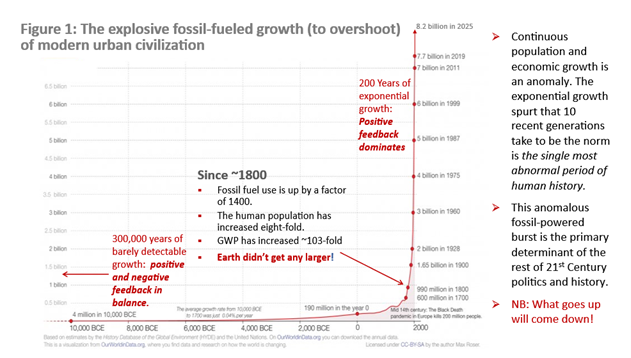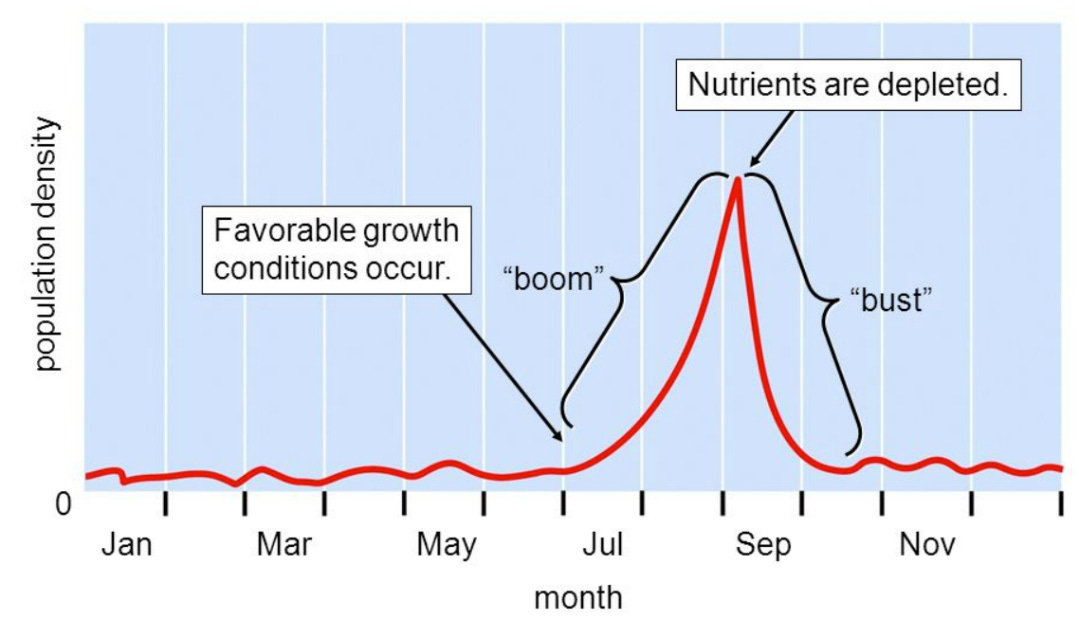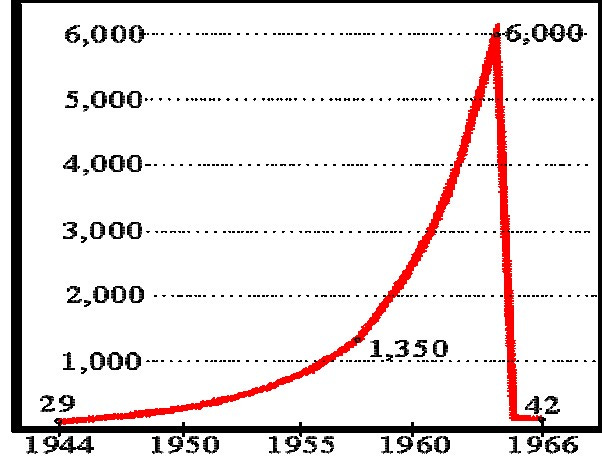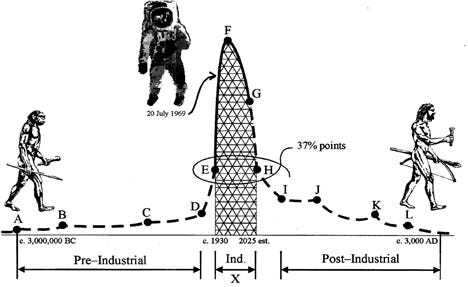Fatal delusions and the curse of ‘maximum power’
‘When spectacular success spells calamitous failure’
What is real?
One of humanity’s more curious traits is an unlimited capacity for self-delusion. And if you don’t think you are delusional, you are doubly deluded.
There are numerous causes of this enigma, many springing from basic human nature. Perhaps the most obvious is that human groups ‘socially construct’ what they take to be reality. People make up elaborate stories (e.g., tribal myths, political ideologies, religious doctrines, economic paradigms, cultural narratives and even scientific theories) and then act out of these stories as if they were real. Even this short list makes clear that every one of us is operating simultaneously from several such fabrications every moment of every day. Most are adequate mirrors of ‘whatever’s out there’ but many are delusional, some dangerously so.
Problems arise when a made-up construct fails accurately to represent some crucial aspect of biophysical reality – and by biophysical reality I mean the world as it actually is.[1] Consider the following example of groundless group-think. An anti-vaccination group forms in your community and launches a determined recruitment effort. Anti-vaxxers tend to be conspiracists, people who believe that governing elites regularly perpetrate elaborate hoaxes on the public. “They think this is just how the world works, and to believe anything else is naïve.”
Consistent with this mindset, your local anti-vaxxers promote their own mythic fantasy: Vaccines are dangerous – medical and government officials are engaged in a coordinated ‘public health’ campaign that lies about the benefits of vaccination and downplays the negative effects. Of course, the better-informed and more critical thinkers among your neighbours know that vaccines have virtually eliminated such virulent diseases as smallpox, polio and even measles; they don’t buy in. But many in the neighbourhood do; they convince the school board to drop its vaccination mandate; vaccination rates begin to fall. Inevitably, disease will (re)gain a foothold as we’ve seen with the measles outbreaks that struck many communities in the US and Canada in 2025. At least three children died.
Reality wins. Delusional beliefs can be dangerous and costly.
The multi-layered master delusion
Now ponder a pervasive mythic construct that affects us all. And I mean all. Everyone in modern techno-industrial (MTI) society is caught up in MTI’s defining cultural narrative whether they know it or like it or not:[2]
Industrial society can enjoy continuous economic growth enabled by ever-advancing technology.
This buoyant construct springs from yet another shared delusion, the quasi-religious concept of human exceptionalism: humans are uniquely different from other species and not really part of nature. Exceptionalism asserts that nurture prevails; biology plays no role in human behaviour; we march to cultural drums exempt from biophysical limits and laws. This helps explain why mainstream economic models consider the economy to be separate from, and essentially independent of, ‘the environment’ in which it is actually embedded, and how smart people can believe in the stupid notion of unlimited growth on a finite planet.
Let’s pause for a moment to savor the irony in this situation. Exceptionalists believe there is no genetic influence human on behaviour, yet engagement in the social construction of ‘reality’ is, itself, an innate characteristic of H. sapiens that helps shape human societies everywhere (albeit in different ways). Moreover, the specific notion of infinite growth reinforces (and may subconsciously spring from) two other survival-oriented heritable traits: the tendencies to expand into any accessible habitat and to use up all available resources.
And it doesn’t end there. H. sapiens evolved in competition with other species – including other extinct ‘hominins’[3] – for both habitat and food (i.e., biomass energy); natural selection for superior intelligence and social organization obviously gave us a leg-up in the competition for both. Science shows that no other large vertebrate species comes close to modern humans in terms of total population, geographic range or our ecological impacts. We are top carnivore and dominant herbivore, often by several orders of magnitude, in every accessible ecosystem. We are the also major geological force changing the face of the planet. It is impossible to square these objective realities with the pan-cultural delusion that the human enterprise is detached from, and operates independently, of ‘the environment’
Mastering ‘maximum power’
Energy ‘factors in’ everywhere so we cannot seriously discuss the role of energy in evolution without reference to ‘free energy’ and ‘maximum power’. I’m not talking here about some spectacular new muscle car or Elon Musk’s latest rocket. ‘Maximum power’ refers to an obscure evolutionary mechanism that should actually be taught in high school.
It’s not all that complicated once you ‘get’ evolution by natural selection. In 1886 the Austrian physicist, Ludwig Boltzmann, connected Darwinian natural selection to the Second Law of Thermodynamics, the entropy law, by observing that the fundamental struggle for life is the competition for low-entropy or ‘free energy’ (aka ‘available energy’). Without free energy, nothing can happen.[4] Building on Boltzmann, ecologist Alfred Lotka hypothesized in 1922 that successful systems and organisms would be those that capture the most available energy and direct it into actions and behaviours that ensured their continued existence. Finally, in the 1960s-1990s, American ecologist Howard Odum and physicist Richard Pinkerton, pulled the threads together to weave the ‘maximum power principle’ (MPP). In effect, the MPP posits that, in the course of evolution, natural selection favours those individuals and systems that self-organize in ways that optimize their appropriations of free energy from their environments and maximize the efficiency with which they convert it for self-maintenance and reproduction.[5]
So, what makes humans stand out in all this? Nothing, really – until very recently.
Anatomically modern H. sapiens has been around for about 300,000 years, mostly a spindly naked ape just holding its own in the great struggle for existence with a population of just a few thousand in what we call Africa today. Then, about 70,000 years ago, humans began spreading in ripples and waves over the rest of the planet. Access to more habitat and food sources enabled our total paleolithic population to reach perhaps four to five million by about 10,000 years BCE. Only by then, with 97% of modern humans’ history behind us, did people in several places around the planet begin to adopt (or were forced to adopt) agriculture as hunting-gathering ran its course (possibly due to local over-population/over-exploitation).
Now things get really interesting. For most of humanity’s 300,000 history, population growth had been negligible, held in check by the uneasy balance between positive feedback (potential exponential population growth) and negative feedbacks – food/resource scarcity, disease, competition for space, other conflicts. But with agriculture, we humans were able to flex our ‘maximum power’ muscle for the first time. This new technology gave us a major competitive advantage – unprecedented access to photosynthesized biomass energy (food) enabling us to leave competing species behind. Even so, it took an additional ~10 millennia for the population to reach 200,000,000 and we didn’t top our first billion until the early 19th century, only ~215 years ago.
By then, of course, the industrial/scientific revolution was underway and the human enterprise was about to explode with improvements in public health and the proliferation of ways to put fossil energy to use (Figure 1).
Note that before the industrial revolution, most of the energy available to humans was in contemporary biomass – food, firewood, dung and peat. These traditional sources comprised 95% of society’s primary energy even in 1825. Most physical work was done by human and animal labor – endosomatic energy[6] – with a little help from mechanical wind and water mills.
Fossil fuel technologies changed everything. Fossil fuels (FFs) provided the cheap, abundant, exosomatic energy[7] needed to produce the food and dig up all the other material resources required to expand the human enterprise. Combined with improving population health (disease control), FFs reduced or eliminated most forms of negative feedback that had historically held humanity in check. This enabled H. sapiens to realize our species’ full potential for exponential population (and everything else) growth for the first time in our evolutionary history.
In just over 200 years – a mere <.1% of that history – modern MTI peoples have burned half of known petroleum reserves and much of the natural gas and coal that took tens of millions of years to accumulate in nature. FFs put human ‘maximum power’ on steroids: since the early 19th Century, the human population has ballooned eight-fold to eight billion and gross world product expanded by a factor of >100, all propelled by a 1400-times increase in fossil fuel consumption (Figure I).
H. sapiens evolutionary ‘success’ is spectacular by any quantitative measure, including the (regrettable) displacement of all competing species from their habitats and food niches. From an insignificant less-than <1% ten millennia ago, humanity now accounts for 32%, and our domestic livestock another 64% of Earthly mammalian biomass. The other several thousand wild mammal species combined cling to the margins of existence at only 4% of total biomass; at least 80 species have been extinguished since 1800. And the human eco-hegemony extends beyond mammals – remaining populations of monitored vertebrates have declined >70% since 1970.
The reason is simple. There is only so much space and bio-energy to go around and what humans appropriate for themselves is irreversibly unavailable to other species.
Oops!
Hard-core anthropocentrists might see this as unqualified good news but there is a problem. This explosion occurred on a finite planet. Humanity’s unprecedented (and unlikely to be repeated)[8] success at leveraging maximum power has shot the human enterprise far into ecological overshoot: we are consuming more bioresources annually than the ecosphere can regenerate and dumping wastes beyond nature’s assimilative capacity. As noted above, humans are, directly or indirectly, the dominant (over)consumer organism in every accessible ecosystem on Earth and our – often toxic – waste generation further undermines global life support systems. Even climate change/global heating – generally perceived as the greatest eco-threat facing civilization – is driven, in part, by the single largest waste product by weight of industrial economies, carbon dioxide (CO2).
Apart from insured storm damage costs, most negative climate effects and other externalized[9] damage costs of overshoot go largely unaccounted by mainstream economists. Disconnected neoliberal models can provide no feedback on the state of the ecosphere. To the extent that society uses market economics as a guide to development it is flying ecologically blind (not a good idea). The better-sighted late ecological economist, Herman Daly, argued decades ago that the world had entered a phase of uneconomic growth where the unmeasured costs of additional growth exceed the benefits; i.e., beyond a certain point GDP growth actually corrodes net human well-being. ‘Economic overshoot’ thus mirrors biophysical overshoot: both recognize that, left unattended, overshoot is ultimately a terminal condition. Civilization cannot for long sustain itself by depleting the biophysical assets or ‘natural capital’ upon which human well-being and survival depends.
Which brings us back to dangerous delusions.
Is MTI culture a ‘one off’ anomaly?
Only ten or 15 out of ~15,000 generations of modern humans have experienced sufficient population and economic growth, and technological development, in their lifetimes to notice significant change (Figure 1). Yet, the most recent generations have ‘socially constructed’ continuous growth to be the norm. Our economies and many institutions depend on continuous growth., Economic planners quail if GDP growth falters below 2-3% per year (which means doubling in 35 and 23 years respectively).
Think about it: MTI societies have canonized as ‘normal’ the single most anomalous period in human evolutionary history and have conned themselves into thinking it can continue indefinitely!
This really is delusion bordering on stupidity. Think about population alone: there is no reason to think human population dynamics differ substantially from those of any other species. All life forms are capable of exponential (aka ‘geometric’) growth under ideal conditions and differ mainly in generation and potential doubling times. In nature, many species exhibit ‘boom-bust’ population cycles; during particularly favorable periods (plentiful food, shelter, few predators, etc.) their populations ‘boom’ but a ‘bust’ inevitably follows when the boomers deplete crucial resources or disease and predation kick in. Some species such as the common house mouse reach damaging-to-humans ‘plague’ levels during the boom phase. Figure 2 provides a text-book illustration.
Figure 2: The ‘classical’ boom-bust cycle in nature
And there is no shortage of real-world examples. In 1944, 29 reindeer were introduced to St Matthew Island off the coast of Alaska. St Matthew was a reindeer paradise with abundant lichens (the preferred food source) and no predators. Within 20 years the population boomed to 6000 animals, only to bust to near extinction from starvation over a single harsh winter. Overgrazing had eliminated most of the lichen (Figure 3).
Figure 3: Population trajectory of St Matthew Island reindeer herd
Here’s the thing. Compare the boom phase of the boom-bust cycles in Figures 2 and 3 with the singular uptick (i.e., ‘boom’) of human numbers over the past three centuries (Figure 1). Ominously similar, no?
No surprise there. Fossil fuels have played the same role for humans, albeit indirectly, as did lichens for St Matthew’s reindeer, and now ‘over-grazing’ is seriously taking its toll on human prospects as well. We are depleting fisheries, have permanently degraded a third of arable land, are draining crucial aquifers (ground-water), are destroying tropical forests with all their biodiversity, and most other ecosystems are in decline.
Energy supply itself is becoming problematic; the average rate at which oil and gas fields decline is accelerating globally and investment in new supplies is insufficient to keep up. Decades ago, engineer Richard Duncan hypothesized that modern civilization would rise and fall with energy use per capita. His Olduvai theory argues that humanity will exhaust accessible FFs and FF-dependent resources, food production would collapse and any “surviving population will have ‘achieved’ permanent sustainability—at the subsistence level” (Figure 4). Don’t succumb to the delusion that renewable sources – all of which are FF dependent – can provide a quantitatively equivalent substitute and avoid the implosion. There is no energy transition.[10] We are on track for a low-energy future and inadequate energy alone would be enough to ‘bust’ the modernity bubble.
Figure 4: Olduvai Theory
Not having anticipated the shale oil boom, Duncan may have misjudged the date of ‘peak civilization’ by a couple of decades but the concept otherwise seems sound.
Then there’s the pollution side: climate change is worsening, ocean anoxic zones are expanding, air, land and waters are being toxified, food supplies are contaminated, mammalian sperm counts are falling, micro-plastic contamination is ubiquitous, etc., etc. And we should also point out that even territorial conflicts (aka ‘resource wars’) are once again on the rise. Earth cannot support even its present population at average material standards. This is the age of terminal overshoot; negative feedbacks are resurging. It is hard to avoid concluding that H. sapiens is nearing the peak ‘boom’ of a one-off population cycle and the ‘bust’ is sure to follow.
Epilogue
The anti-vaxxer mentality prevents people from taking action that would prevent disease. Similarly, economists, eco-modernists and other techno-optimists tell us not to fret, not to bother with plans and strategies that could at least ameliorate a ghastly future – human ingenuity will find the technologies needed to overcome any constraints on future growth and human flourishing. This is a fraying faith-based mantra (aka, ‘tired delusion’). The past half century has been a period of unbroken techno-innovation but ecological degradation has accelerated. Consider just global heating, the one symptom of overshoot the world seems to have noticed. The UN Framework Convention on Climate Change was birthed in 1992, launching the Conference of the Parties (COP) process to reduce emissions and atmospheric carbon dioxide levels. Thirty-three years and twenty-nine COP conferences later, emissions have actually increased by 60% and are still rising with increasing fossil fuel use. In 2025 atmospheric CO2 concentrations reached an all-time high, averaging 427 parts per million,[11] and track relentlessly upwards. Techno-optimism blinds society to such contrary scientific evidence (and the US is even into dismantling the capacity to acquire it). We are tempting climate chaos and eco-collapse; humanity’s unqualified ‘maximum power’ success is morphing into calamitous curse.
As some wag once opined, “Making predictions is difficult, especially about the future”. That said, put aside vacuous hope, ungrounded optimism, and various other species of fatal delusion for the moment. Get real! Focus only on the unrelenting cascade of objective evidence, of accelerating eco-degradation in light of human behavioural history and our species evident cognitive limitations. Embracing truth is not the path to despair but rather the first step toward creative crisis management. What do you think the odds are that MTI society, on its present tack, can avoid a harsh reckoning with biophysical reality, one that means suffering and worse for billions in coming decades?
[1] Astute readers will realize that delusion machines are working overtime reconstructing both real time and history in the verbal bedlam that passes for contemporary political discourse, particularly in Trump’s USA, today.
[2] Actually, most people are not likely even aware that they – or society – even has a ‘narrative’. Ask a dozen folks at random on the street to describe society’s dominant narrative or ‘worldview’ and see what response you get.
[3] Extinct species of Homo may have attained that status because H. sapiens pushed them over the brink.
[4] ‘Free energy’ is energy that can be extracted to do useful work. A swimming pool at 25o C (77 o F) contains more energy than a litre of gasoline, but the pool is in thermal equilibrium with its environment so its energy is ‘unavailable’. The chemical energy in that gasoline, however, can be released to power your motorcycle over 25 km (16 miles) of hilly countryside – and heat a lot of air in the process.
[5] ‘Power’ is a measure of the rate of useful energy conversion. Merely maximizing energy intake and wasting it confers no advantage. As an evolutionary strategy, ‘maximum power’ implies, in part, the ability to maximize the proportion of captured energy and resources are converted into surviving offspring.
[6] ‘Within the body’ energy.
[7] ‘Outside the body’ energy.
8 British astronomer, Sir Fred Hoyle, speculated in 1964 that technical civilization was necessarily a ‘one-shot affair’.
[9] ‘Outside the market’, not reflected in consumer prices.
[10] And if there were, we’d be further into destructive overshoot – some other critical shortage(s) or negative feedback(s) would eventually take us down.
[11] 52% above pre-industrial levels






In answer to your last question, my guess is that there is zero chance of avoiding a hard reckoning with biophysical reality. Humans can't avoid reality. It's impossible. However, there is a hypothetical chance of humans choosing to ease the way down. I don't think that chance is much above zero.
Zero (to answer your last question).
What I can't understand is why this isn't obvious to everyone?
I recently asked my community, once again, to consider degrowth. I asked this not as an attempt to "avoid a harsh reckoning with biophysical reality," which I think is impossible, but rather to help people and the community to prepare for leaner, rougher times ahead.
Unfortunately, even having a discussion about it is impossible (it seems). Almost no one is even willing to contemplate the idea, much less take any steps in that direction. Why is it that what Bill has laid out here is not visible, not understandable, not within the realm of possibility, for 99.99% of people today? It's so astonishing!
I'm curious: To the other commenters on this article, what is everyone's date for when collapse will be completely obvious to everyone because it's so bad? Yes, I agree predicting the future is both impossible and foolish, but we all have a date in mind despite that, don't we? Be honest :-) My guess for the date when collapse is obvious to everyone, even those most entrenched in human exceptionalism--yes, even economists!--is 2050.
But then there is a small part of me that thinks many people will fight to the very end to deny the obvious. So, maybe there never will be such a date. Humanity will end, or go back to 3-5 million, and all the while everyone will cling to the delusion that "we are too special for this to actually be happening."
In the meantime, I spent the day planting native wildflower and grass seeds, hoping a few pollinators survive our gauntlet of destruction.